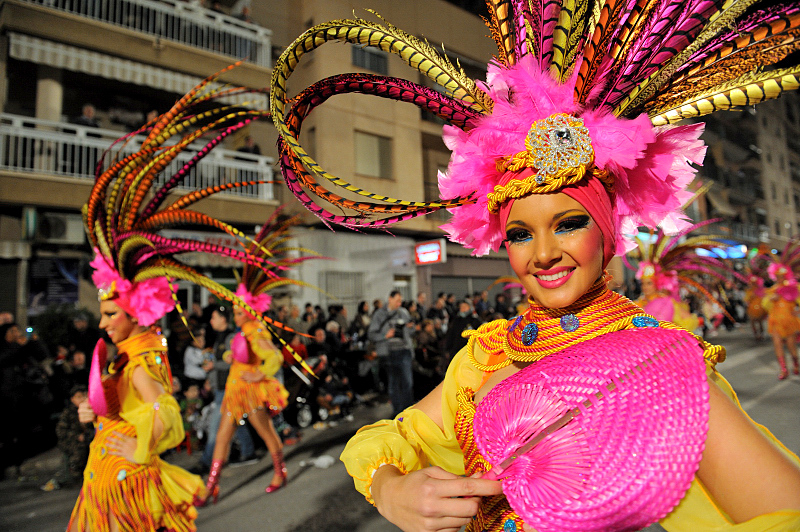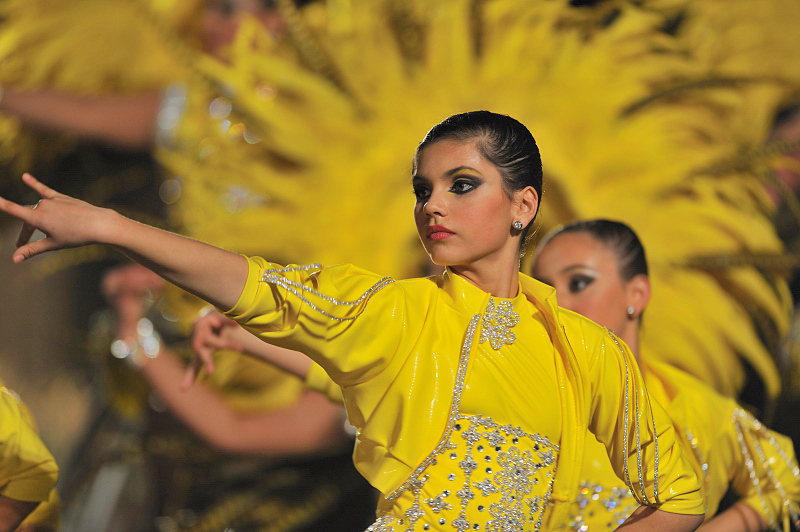Welcome to Carnival in Murcia
Carnival in the Region of Murcia takes place forty days before Easter, filling the region with vibrant parades and enthusiastic celebrations as the peñas party before the onset of Lent.
Nobody in Spain misses out on the chance to don a colourful costume and enjoy themselves, and you’ll find events in most municipalities, although there are some which have made Carnival an artform and put on an exceptional display.
Foremost is Águilas, which has the biggest carnival in the region, renowned for its lines of perfect dancers and extravagant costumes, with Cartagena also offering a substantial parade and a major competition for the witty and irreverent chirigotas.
Santiago de la Ribera closes the week with a large daylight parade in the Mar Menor, Cehegín hosts the largest carnival of the north-west and in central Murcia Cabezo de Torres is the largest in the centre of the region. In-between are many more processions, with all ages participating, so come and join the party.
See below for a full introduction to Car-naval in Spain and more information about the chirigotas.
What Is Carnival
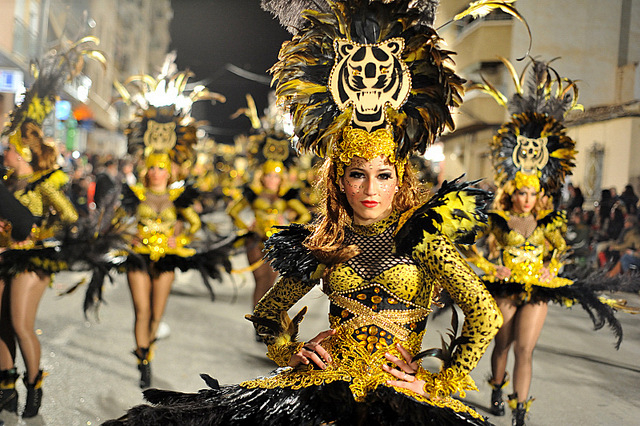
Who are Don Carnal and Doña Cuaresma?
Carnaval is coming, but what's it all about?
Excitement is visibly growing as carnival time approaches, tantalizing glimpses of feathers, glitter and sequins through garage doors as final touches are put to some of the most spectacular costumes you'll see this year.
It's a time of excess, the final fling before the door of pleasure closes and we're into the time for denial and abstinence, Carnival always taking place forty days before the beginning of Easter,starting with Lent and then moving into Semana Santa.
Carnival in Spain, when did it all start?
Its roots lie shrouded in pagan celebrations at the end of the Winter and the beginning of Spring, and as the Romans spread across Europe the festival became incorporated into their calendar as the Lupercalia celebration, which took place on 15th February each year. Within 400 years it had become enmeshed in Roman Christianity which embraced cultures and traditions from across Europe and both the original pagan festival and Lupercalia were absorbed into the Christian calendar.
The actual word Carnival is linked to the idea of meat and food, feasting and excess. Carnival- carna-val here, comes from the latin word for flesh, "carnis," this word having overtones of not only the meat of an animal, but sensuality, and living human flesh.
The words carnem levare, meaning "put away meat", which refers to a meal or a feast before abstinence,evolved into carnevale , the Italian name for the day that later became known as Shrove Tuesday. 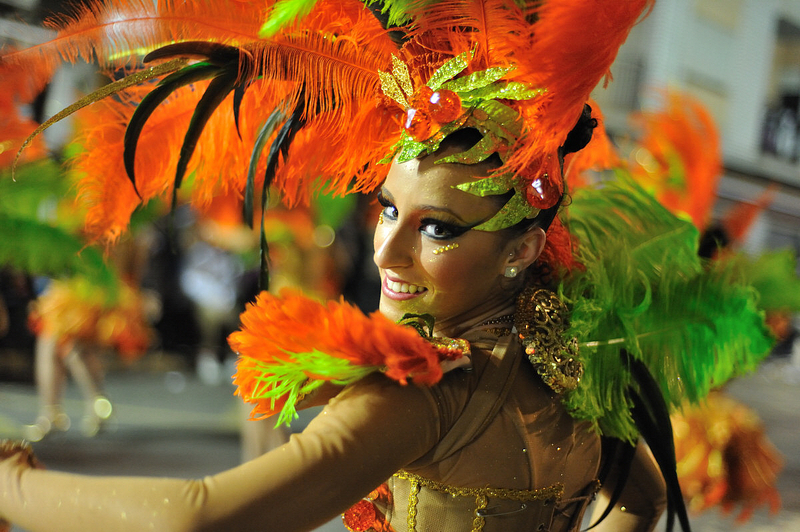 In Italy the word Carnevale was used to celebrate the time just before Lent, a feast of the flesh in more ways than one.
In Italy the word Carnevale was used to celebrate the time just before Lent, a feast of the flesh in more ways than one.
Following the collapse of Rome, Christianity took hold throughout Europe and by the Mediaeval period, the feast of carnevale had become entwined with Christianity and was part of the Shrove Tuesday traditions, which was much more than just eating pancakes as we do today, but was a time of riotous behaviour, the time when cravings for flesh were satisfied, feasts, wild celebrations and sating of carnal lusts took place before the onset of abstinence. In mediaeval Europe fear, penance and self-debasement were seen as a key to unlock the doors of heaven and during this time it was not uncommon to find processions of pilgrims shuffling along on their knees as part of the forty days of self-sacrifice before Easter.
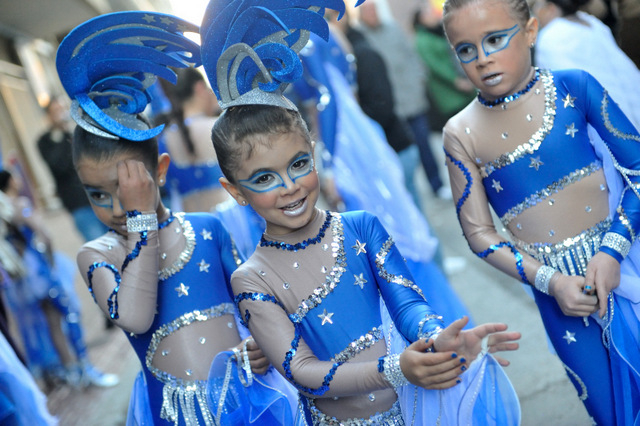
Bawdy celebrations and songs reigned, pleasure, over-indulgence and satire, plays, ridicule and open air theatre where chaos was King.
As in many celebrations, a figure would rule the feasting, and in mediaeval Spain the character which we see today, Don Carnal, first emerged.
A book survives from 14th century Spain in which one of the principle characters of Carnaval appears, a book {image3}called El libro de buen amor, written in 1330 which is a famous book of poetry celebrating some of the best loved stories and traditions of the time, and one of them is a battle between Don Carnal and Dona Quaresma, a satire paradying the church and the excesses committed by some of the clergy.
Don Carnal represents the carnal pleasures of life, and is portrayed on his throne, surrounded by plates of meat, dripping with juices, oozing excess and lust, entertained by his jesters, musicians and pleasures, cocks crowing as he's just eaten their wives.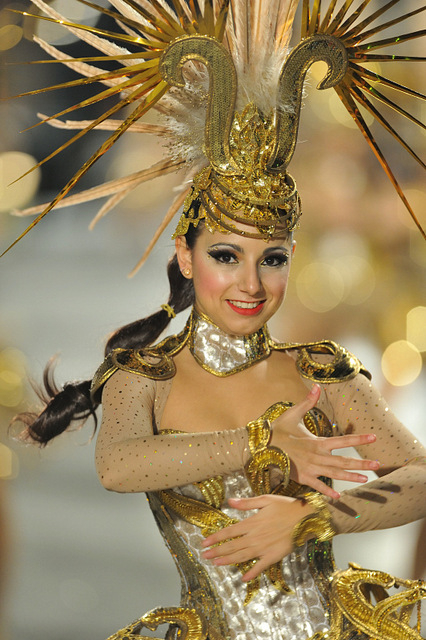
Opposite to him is Dona Quaresma, who portrays lent, austerity, self denial and abstinence, sitting surrounded by her dishes of fish and vegetables.
There's a big battle, (Carnival) She wins and imprisons him, (Lent), he escapes and mobilizes his forces of sheep, goats and cattle, she capitulates ( end of lent), they join together in buen amor(Semana Santa) and finally he takes control as we party into the fiestas which follow Easter.
This battle between Don Carnal and Dona Quaresma is played out in carnivals throughout Spain, with most towns electing two of their most popular citizens to play these 2 roles.
You'll see them throughout the celebrations, Don Carnal ruling the carnival, with mischief, merrymaking and excess in abundance, culminating in a battle between the two of them, which is won by Dona Quaresma.
Don Carnal is banished, which takes the form of the burning of Don Carnal at the end of the celebrations, an act which you will find tie and time again throughout regional celebrations, such as the fallas of Valencia, at the end of their 4 day period of festivities..
For most onlookers in Murcia, the processions are the main highlight of the week, some on a larger scale than others.
If you want to really experience Carnival, it's well worth going to one of the big parades in Lorca, Cartagena or Águilas. There are also some large parades in the Murcia suburbs, although nothing in the centre of the main city itself.
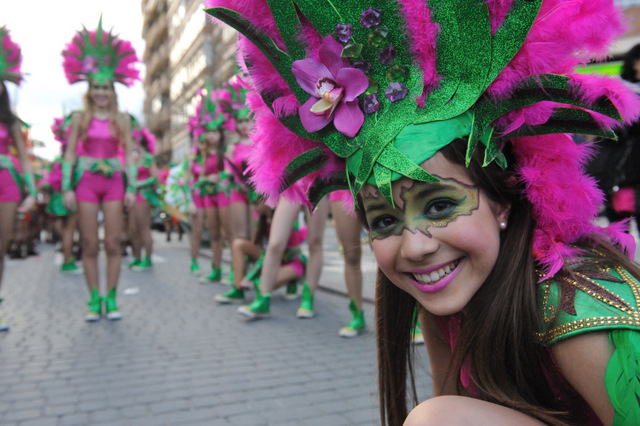 Águilas is the most celebrated of all and seats are on sale now for this carnival. As with all of these parades, you don't have to buy a seat in advance, but the parades go on for hours, so its well worth it.
Águilas is the most celebrated of all and seats are on sale now for this carnival. As with all of these parades, you don't have to buy a seat in advance, but the parades go on for hours, so its well worth it.
Cartagena also has a large carnival with one main parade, San Javier has a large parade, usually the last of the festivities, and Totana is growing in size as well.
What Is A Chirigota
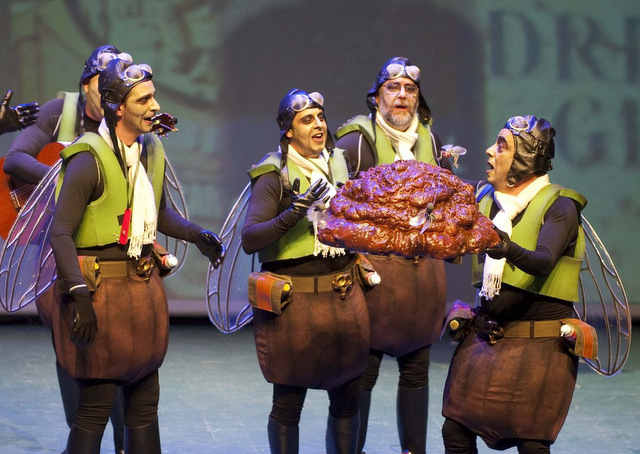
Just what are carnival (carnaval) chirigotas?
Chirigotas are a remnant of the mediaeval traditions of Carnaval, the night before lent began on which chaos reigned supreme.
Throughout mediaeval Europe it was common to have a symbolic "King" of celebrations, something which you'll see at all times of year, and during the time of his kingship, wit, tomfoolery, lewd jokes and mockery, were all part of his remit. He would be surrounded by his court of jesters and fools, and forfeits for not carrying out his commands would have to be paid.
Don Carnal, who we see throughout the carnival fiestas, surfaces in mediaeval poetry, surrounded by his fools and jesters, as he still does today.
Part of the tradition of mockery was the performance of risqué songs and verses, witty mockeries of figures and political associations, a time when opinions could be voiced satirically.
This is the tradition which is followed by the chirigotas.
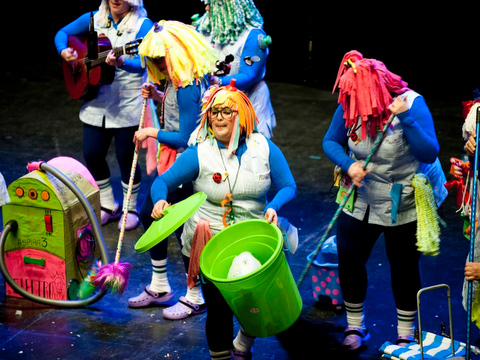
These groups are formed by groups of friends, who don a costume and perform witty songs and routines which poke fun at the establishment, politicians, prominent public figures, topics of daily life and each other.
They're very accomplished routines, practiced to perfection and are a very popular feature of the carnival. During the week, youll see them performing and entertaining the public, and such is their popularity that there is a huge competition which takes place in Cadiz, in which chirigotas from all over Spain participate. Within the region of Murcia there is a major competition in Beniel and another in Cartagena.
The verse however, is in Spanish, so whilst it's an experience to come across a Chirigota in the street, it may not be worth expats purchasing tickets for competitions, unless they speak good Spanish and have a thorough knowledge of contemporary Spanish politics, as many of the jokes are directed at politicians and local figures, as well as current affairs and hot local issues.
Images: Cartagena Chirigotas
